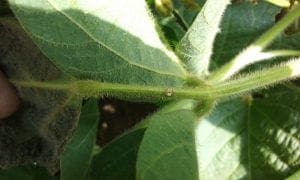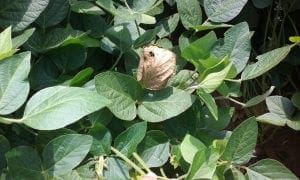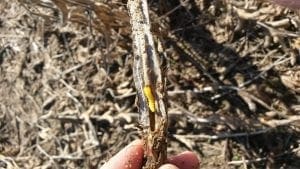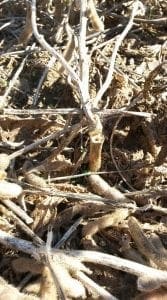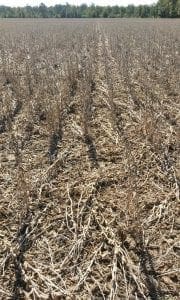Did your field look like this? If so, your field may have been infested with Dectes stem borers.
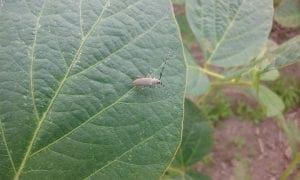
Photo2: Adult Dectes stem borer
The Dectes stem borer adult is a long horned beetle, approximately 3/8-1/2” in length, grey, with long antennae that are banded black and grey. Adult beetles begin emerging in late June and are present in soybean fields until mid-August. Female beetles lay a single egg into the pith tissue of a soybean plant by chewing a hole into the plant’s epidermis and inserting her ovipositor into the plant.
Once the egg hatches, the larva tunnels up and down the inside of the plant, feeding on the pith tissue. If the egg is laid in the stem of a petiole, the petiole will wilt and drop from the plant when the larva tunnels into the main stem of the plant. This is sometimes referred to as “flagging”.
Once in the main stem of the plant, the larva will continue traveling up and down the inside of the soybean plant, feeding on the pith tissue. Once the plant begins to senesce, as early as late September, the larva will create a chamber to overwinter in by girdling the inside of the soybean stem several inches above the soil surface and depositing a frass plug immediately below the girdled area of the stem. Dectes stem borers overwinter as larvae, pupate in early summer and adults begin emerging in late-June, completing the life cycle.
The overwintering behavior of Dectes stem borer larvae makes plants prone to lodging. Under heavy infestations and when harvest is delayed, lodging losses can be as much as 15 bushels per acre. Physiological losses due to the tunneling activity of the larvae during the growing season has been difficult to document but research has suggested that losses could be as high as seven percent.
There is not an established threshold for Dectes stem borer adults. However, sweep net sampling can be used from late June through mid-August to identify fields with adult infestations. Plants can also be visually inspected for ovipositioning scars and wilted petioles to identify fields with potential larval infestations.
To confirm that a plant is infested with a Dectes stem borer larva and to determine the risk for lodging losses, cut the plant lengthwise with a knife, looking for larva and or feeding damage. This can be done as early as mid-September. Knowing if a field is infested with Dectes stem borers and the severity of the infestation is important because lodging losses can be minimized by timely harvest.
Insecticide applications, both foliar and at planting, have not been successful in significantly reducing larval infestations. Only the adult beetles can be targeted because the eggs are laid directly into the plant and the larvae never leave the host plant. We have been able to achieve temporary reductions of adult beetle populations with foliar insecticide applications; however, because the adult emergence occurs over a large window, fields can quickly become re-infested. We have had mixed results with multiple insecticide applications because it is not only difficult to time the applications, but it also is generally not economical.
Some cultural control practices that can reduce the risk of yield loss from Dectes stem borer include:
- Early/timely harvest: Scouting for Dectes stem borer adults and larvae can identify fields at risk and used to schedule harvest.
- Crop rotation: For this to be successful, a field would need to be isolated from other fields or would require an area wide adoption since the beetles can easily fly from their overwintering locations to neighboring soybean fields.
- Fall plowing: Research has indicated that plowing 2-3” deep can result in 60-70% reduction of beetle emergence in the summer. This would also likely need to be adopted area wide to have significant impacts.
- Weed control: Dectes stem borers also use some weeds as host plants including giant ragweed, common cocklebur, and wild sunflowers. Weed control within and around the perimeter of fields is also important.
- Row spacing: There are no differences in the severity of an infestation or number of lodged plants. However, in fields planted in narrow rows (7-15”) lodging losses may be reduced because the lodged plants are held up to some degree by the surrounding plants.
- Variety selection: Experience in Delaware suggests that lodging loss is typically more severe in shorter season varieties (Group II, II and early IV’s). Larvae will infest most varieties; however, some are more prone to lodging, especially in drought conditions.
Click to View
Dectes Stem Borer Management in Soybeans Fact Sheet
Having little success reducing lodging losses with insecticides, we decided that instead of trying to manage the insect pest, maybe a better approach would be to see if we could change the way we manage our soybean plants to reduce lodging losses from Dectes stem borers. In 2017, we conducted research to investigate the role plant populations can play in increasing stem diameter (strength) to reduce lodging losses from Dectes stem borers while maintaining yield potential under irrigated and non-irrigated soybean production. This research was conducted at the University of Delaware’s Warrington Farm and was funded by the Delaware Soybean Board.
Related research funded by the Delaware Soybean Board:
- Can Plant Population Play a Role in Reducing Lodging Losses in Soybeans from Dectes Stem Borer?
- Area Wide Evaluation of Multiple Insecticide Applications to Control Dectes Stem Borer in Soybeans-Another Try!


